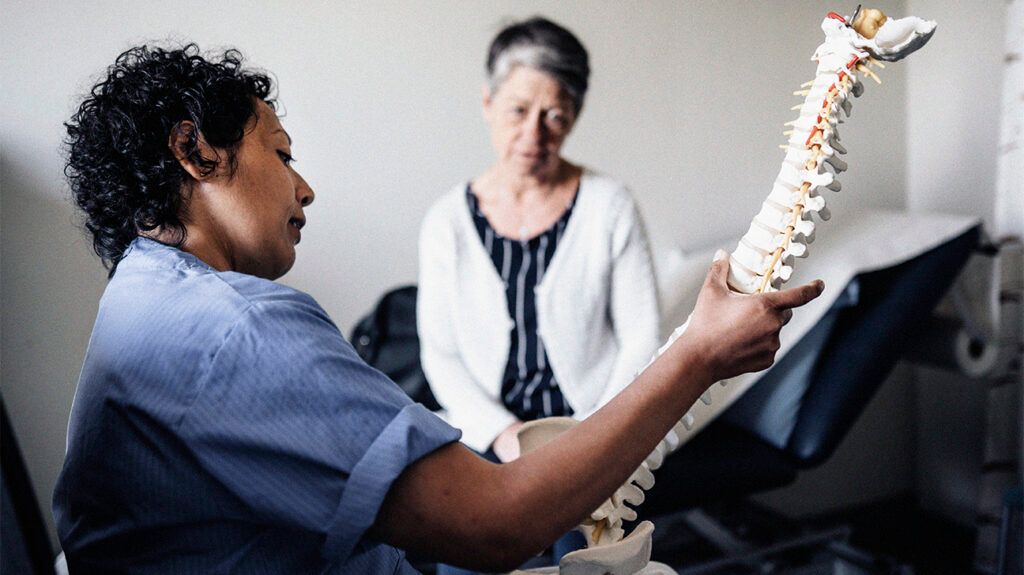The Schober test is a physical exam to evaluate the mobility of the lower back. The test can help diagnose ankylosing spondylitis, a type of arthritis that affects the spine and hips.
During the test, a doctor draws two horizontal lines across a person’s lower back. After asking the person to bend forward, they measure the distance between the two lines. The difference between the standing and bending measurements indicates how well the spine can flex.
Several modifications of the Schober test aim to increase its accuracy and reliability. These include the modified Schober test, the modified-modified Schober test, and the Wolfson modified Schober test.
Read on to learn more about the Schober test and why doctors use it to help diagnose ankylosing spondylitis.

The
The test measures the range of motion in the lumbar spine, which is the section of the spine in the lower back. Healthcare professionals may refer to this range of movement as “lumbar flexion.”
When a person flexes their back, they are bending forward. The greater the flex, the more bent forward they are. For example, they may be able to touch their ankles or toes.
People with ankylosing spondylitis have less mobility of the lumbar spine, making bending forward difficult. Consequently, they
During the Schober test, a doctor draws a small horizontal line across the spinous process — the area where ligaments attach to the spine — at the fifth lumbar vertebra (L5). They also draw another line
The person then bends forward and attempts to touch their toes. Once the person cannot bend anymore, the doctor measures the distance between the two lines.
The bigger the difference between the standing and bending measurements, the more flexible the spine is.
An increase of more than 5 cm in length when bent over indicates a healthy range of spinal motion. Measurements of fewer than 5 cm suggest the spine is not as flexible as it should be.
There are various
Modified Schober test
This form of the test involves the following steps:
- The doctor finds the posterior superior iliac spine (PCIS) on the left and right sides of the lower back. The PCIS sometimes appears as a dimple or a bony prominence.
- They draw a small horizontal line between the two PCIS points.
- They draw two more lines, one 5 cm below and the other 10 cm above the horizontal line.
- The person bends forward.
- The doctor records the distance between these two lines.
Modified-modified Schober test
This version involves the steps below:
- The doctor locates the PCIS on both sides of the back.
- They find and mark the center point between them with a small horizontal line.
- They draw another line 15 cm above this point.
- The person bends forward.
- The doctor measures the distance between the top and bottom lines.
Wolfson modified Schober test
This modification involves the following steps:
- The doctor marks the center point between the PCIS with a small horizontal line.
- They mark a second horizontal line 16 cm above this line.
- The person flexes forward as much as they can.
- The doctor measures the distance between the two lines.
A positive Schober test result is when the distance between the two lines does not increase by at least 5cm when the person bends forward.
This could indicate ankylosing spondylitis or another condition that reduces how much the spine can flex. However, further tests and imaging studies
A key benefit of the Schober test is that it is a noninvasive diagnostic tool with no recovery period. A person can learn more about the cause of their symptoms and what may help reduce their stiffness or pain within one day.
In addition to the Schober test, a doctor will want to learn more about the person’s medical history and
The Schober test had some validity issues as it may not be able to measure the lower back accurately in some people.
The modified Schober test attempted to address these issues but could not measure the lumbar spine’s first (L1) and second (L2) vertebrae precisely.
The modified-modified Schober test improved accuracy somewhat. However, it was also unable to measure the top end of the lumbar spine without error. Further adjustments were necessary.
In the Wolfson modified Shober test, researchers increased the measurement from
While this improvement has increased the test accuracy rate to nearly 100%, the additional 1 cm can sometimes overlap into the segment between L1 and the twelfth thoracic vertebra, introducing some error.
The Schober test has been through several iterations. The Wolfson modified Schober test is the most accurate and up-to-date version.
The
